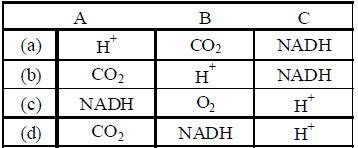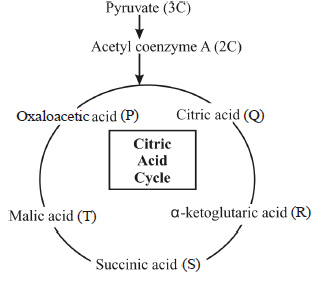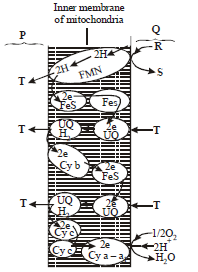Please see Chapter 14 Respiration in Plants Exam Questions Class 11 Biology below. These important questions with solutions have been prepared based on the latest examination guidelines and syllabus issued by CBSE, NCERT, and KVS. We have provided Class 11 Biology Exam Questions and answers for all chapters in your NCERT Book for Class 11 Biology. These solved problems for Biomolecules in Class 11 Biology will help you to score more marks in upcoming examinations.
Exam Questions Chapter 14 Respiration in Plants Class 11 Biology
Objective Question
Question. The formation of acetyl coenzyme A from pyruvic acid produces (in addition to acetyl coenzyme A) one molecule of A , one molecule of B , and one molecule (ion) of C , Identify A, B and C respectively.

Answer
D
Question. In citric acid cycle, energy bond (GTP) is produced as a result of conversion of
(a) citric acid to α-keto glutaric acid.
(b) succinic acid to malic acid.
(c) succinyl – CoA to succinic acid.
(d) succinic acid to succinyl – CoA.
Answer
C
Question. Acceptor of acetyl Co-A in Kreb’s cycle is
(a) malic acid
(b) fumaric acid
(c) a-keto glutaric acid
(d) oxaloacetic acid
Answer
D
Question. Electron Transport System (ETS) is present in
(a) inner mitochondrial membrane.
(b) mitochondrial matrix.
(c) chlorophyll.
(d) chloroplast.
Answer
A
Question. Terminal cytochrome of respiratory chain which donates electrons to oxygen is
(a) cyt. b
(b) cyt. c
(c) cyt.
(d) cyt. a3
Answer
D
Question. The F1 headpiece is a
(a) peripheral membrane protein complex.
(b) integral membrane protein complex.
(c) transmembrane protein.
(d) carrier protein.
Answer
A
Question. The main purpose of electron transport chain is to
(a) cycle NADH + H+ back to NAD+
(b) use the intermediates from TCA cycle
(c) breakdown pyruvate
(d) all of the above
Answer
A
Question. The correct sequence of electron acceptor in ATP synthesis is
(a) cyt a a b c
(b) cyt b c a a3
(c) cyt b c a3 a
(d) cyt c b a a3
Answer
B
Question. Refer the given equation and answer the question.
2(C51H98O6 ) + 145O2 →102CO2 + 98H2O + Energy
The R.Q of above reaction is
(a) 1
(b) 0.7
(c) 1.45
(d) 1.62
Answer
B
Question. The overall goal of glycolysis, Kreb’s cycle and the electron transport system is the formation of
(a) ATP in one large oxidation reaction
(b) sugars
(c) nucleic acids
(d) ATP in small stepwise units
Answer
D
Statement Type Questions
Question. Which of the following is incorrect regarding the Kreb’s cycle?
(a) It is also known as tricarboxylic acid cycle.
(b) It occurs in mitochondria.
(c) It starts with six carbon compound.
(d) It does not involve any decarboxylation step.
Answer
D
Question. Which of the following statement is correct in relation to the ETS?
(a) It is present in the mitochondrial matrix.
(b) Oxidation of one molecule of NADH gives rise to 2 molecules of ATP, while that of one molecule of FADH2 produces 3 molecules of ATP.
(c) Oxygen acts as the final hydrogen acceptor.
(d) In respiration, light energy is utilized for the production of proton gradient.
Answer
C
Question. Which of the following statement regarding pyruvate during aerobic respiration is incorrect?
(a) It is formed by the glycolytic catabolism of carbohydrates in the mitochondrial matrix.
(b) It enters mitochondrial matrix & undergoes oxidative decarboxylation.
(c) The conversion of pyruvic acid to acetyl CoA is catalysed by pyruvic dehydrogenase.
(d) Two molecules of NADH are produced from the metabolism of two molecules of pyruvic acid.
Answer
A
Question. Which of the following statement(s) concerning ATP synthesis is/are correct?
(a) ATP can be synthesized through substrate level phosphorylation, photophosphorylation and
oxidative phosphorylation.
(b) The proton-motive force is the establishment of proton gradients and electrochemical potentials
across the inner membrane.
(c) Proton-motive force is essential for back flow of H+ from outer chamber of matrix of mitochondria through proton channel (F0) of F0 – F1 particle to produce ATP.
(d) All of the above
Answer
D
Question. Which of the following statements (i to v) regarding glycolysis are correct.
(i) It is ten enzymatic reactions that convert a six-carbon molecule to a three carbon pyruvate and result in a net gain of 2 ATP molecules.
(ii) Glucose undergoes partial oxidation to form one molecule of pyruvic acid.
(iii) Glucose is phosphorylated to give rise to glucose – 6 – phosphate by the activity of the enzyme
phosphofructokinase.
(iv) The scheme of glycolysis was given by Gustav Embden, Otto Morrison, and J. Parnas and is often
referred to as the EMP pathway.
(v) ATP is utilized at two steps: first in the conversion of glucose into glucose 6-phosphate & second in
the conversion of fructose – 6- phosphate to fructose 1 ,6-disphosphate.
(a) (i), (iv) and (v)
(b) (iii) and (v)
(c) (iv) and (v)
(d) (ii) and (iv)
Answer
A
Matching Type Questions
Question. In the given columns, column-I contain complexes and column-II contain their alternative names. Select the correct match from the option given below.
| Column – I | Column – II |
| A. Complex I | I. Cytochrome bc 1 complex |
| B. Complex II | II. NADH dehydrogenase |
| C. Complex III | III. ATP synthetase |
| D. Complex IV | IV. FADH2 dehydrogenase |
| E. Complex V | V. Cytochrome c oxidase |
(a) A – III; B – V; C – I; D – IV; E – II
(b) A – II; B – V; C – I; D – IV; E – III
(c) A – II; B – IV; C – I; D – V; E – III
(d) A – IV; B – I; C – II; D – V; E – III
Answer
C
Question. Which of the following is incorrectly matched?
(a) Protein → Degarded by proteases
(b) Fats → Fatty acid + PGAL
(c) Kreb’s cycle → Carboxylation
(c) Respiratory pathway → Amphibolic
Answer
C
Critical Thinking Type Questions
Question. Respiration is the breakdown of
(a) C-C bonds
(b) C-H bonds
(c) H-H bonds
(d) C-N bonds
Answer
A
Question. Life without air would be
(a) reductional.
(b) free from oxidative damage.
(c) impossible.
(d) anaerobic.
Answer
D
Question. During glycolysis, glucose split into
(a) two pyruvic acid molecules.
(b) two coenzyme A molecules.
(c) two lactic acid molecules.
(d) one lactic acid plus one ethanol molecule.
Answer
A
Question. Which of the following is correct sequence in Kreb’s cycle?
(a) Isocitric acid →Oxalosuccinic acid → α-ketoglutaric acid
(b) Oxalosuccinic acid → Isocitric acid → α-ketoglutaric acid
(c) α-ketoglutaric acid → Isocitric acid → Oxalosuccinic acid
(d) Isocitric acid → α-ketoglutaric acid → Oxalosuccinic acid
Answer
A
Question. If hexokinase, an enzyme that catalyzes the first step reaction in glycolysis is blocked then what will be its impact on glycolytic pathway ?
(a) Glycolysis will speed up.
(b) Glycolysis will slow down.
(c) Glycolysis will stop.
(d) Glycolysis will occurs normally.
Answer
C
Question. How many molecules of ATP are produced during glycolysis?
(a) 2
(b) 4
(c) 6
(d) 8
Answer
A
Question. For bacteria to continue growing rapidly when they are shifted from an environment containing O2 to an anaerobic environment, they must
(a) produce more ATP per mole of glucose during glycolysis.
(b) produce ATP during oxidation of glucose.
(c) increase the rate of glycolysis.
(d) increase the rate of TCA cycle.
Answer
C
Question. Fermentation takes place
(a) under anaerobic conditions in many prokaryotes and unicellular eukaryotes.
(b) under aerobic conditions in many prokaryotes and unicellular eukaryotes.
(c) under anaerobic conditions in all prokaryotes and unicellular eukaryotes.
(d) under aerobic conditions in all prokaryotes and unicellular eukaryotes.
Answer
A
Question. Initial step of TCA cycle to yield citric acid starts with the condensation of
(a) acetyl group with OAA & H2O & catalyzed by the enzyme citrate synthase.
(b) acetyl group with pyruvate & H2O & catalysed by the enzyme citrates synthase.
(c) acetyl group with OAA & H2O & is independent of the enzyme.
(d) none of the above.
Answer
A
Question. In Kreb’s cycle, the conversion of succinyl CoA to succinic acid requires
(a) Acetyl CoA + GDP + iP
(b) CoA + GTP + iP
(c) Acetyl CoA+ GTP + iP
(d) GDP + iP
Answer
D
Question. Which one of the following is complex V of the ETS of inner mitochondrial membrane?
(a) NADH dehydrogenase
(b) ATP synthetase
(c) Succinate dehydrogenase
(d) Ubiquinone
Answer
B
Question. In mitochondria, protons accumulate in the
(a) outer membrane
(b) inner membrane
(c) inter membrane space
(d) matrix
Answer
C
Diagram Type Questions
Question. Refer the figure of citric acid cycle and choose the correct combination of labelling (P, Q, R, S and T) the number of carbon compounds in the substrate molecules, involved in the given figure.

(a) (P) 4C, (Q) 6C, (R) 5C, (S) 4C, (T) 4C
(b) (P) 6C, (Q) 5C, (R) 4C, (S) 3C, (T) 2C
(c) (P) 2C, (Q) 5C, (R) 6C, (S) 4C, (T) 4C
(d) (P) 4C, (Q) 6C, (R) 4C, (S) 4C, (T) 5C
Answer
A
Question. In the given figure of electron transport chain – identify P, Q, R, S and T.

(a) P – Matrix, Q – Outer membrane, R – RMNH2, S – NADH2, T – 2H
(b) P – Inter membrane space, Q – Matrix, R – NADH + H+, S – NAD+, T – 2H+
(c) P – Outer membrane, Q – Cristae, R – NAD, S – NADH + H+, T – H
(d) P – Cristae, Q – Outer chamber, R – NADH + H+, S – NAD, T – 2H+
Answer
B
